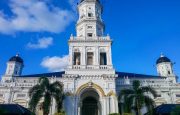Description
Masjid Negeri Sultan Abu Bakar, acknowledged as the state mosque of Johor, is a historical building located on Ledang Hill, which also faces the Straits of Tebrau. It was built in 1892 and completed in 1900 at a construction cost of approximately 400,000 Malayan dollar. The draughtsman for the plan was Tuan Haji Mohamad bin Haji Arif bin Haji Punak (Haji Siwek) while the engineer was Dato’ Yahya bin Awaluddin.
The mosque was officially opened by the late Sultan Abu Bakar with the accompaniment of 21 cannon shots and witnessed by the Menteri Besar of Johor at that time, Dato’ Jaafar bin Haji Mohamad. The design of Masjid Sultan Abu Bakar was influenced by the architecture of the Victorian era and Mughal Indian architecture.
The use of simple ornamentations of the arches while still retaining the shape, bears similarity to an Indian palace, the Man Mandir Palace in Gwalior, Madhya Pradesh, India. Twin columns used on the facade of the mosque show the influence of Victorian architecture. The design of the mosque’s plan is rectangle and at each side of the building is a four-storeyed high minaret with a dome. The mosque has a main prayer hall that is rectangular in shape with bumbung perabung lima (five ridge roof) and surrounded by a 1.5 metres (five feet) walkway along its three sides. The eastern part of the mosque is connected to the ablution area that is located at ground level.
One unique feature of the colonial mosque is the wall moulding. This wall moulding is found along the exterior of the mosque. The main functions of these are as decoration and also to prevent rain water from flowing on the surface of the wall and entering the windows or openings along the walls. Among the areas where the mouldings are used are along the walls including the connection between the wall and the ceiling, base of the columns and parapet wall between the columns, at the capital of the columns and the facade of the building including the arches. Stucco plaster is the material used to make the mouldings. The craftsmen usually cut, carve or make groove lines on the masonry walls.




There are no reviews yet.